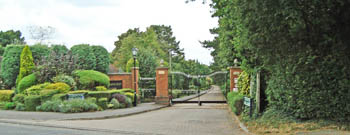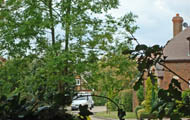Infectious diseases. Later, geriatric.
In October 1893 the Joint Hospital Board, with representatives from Epsom Rural District Council and Sutton and Carshalton District Councils, met to discuss the provision of an isolation hospital. (Epsom Urban District Council had declined to join the venture and built its own isolation hospital.) In 1894 the Leatherhead Urban District Council also joined the Board.
Walnut Tree Farm, near Banstead Downs, was offered for sale by the Revd E.W. Northey and was purchased as the site for the new hospital.
The Hospital opened in October 1897, despite opposition from the local population. It was named Cuddington Isolation Hospital, after its location. It had 14 beds for scarlet fever patients, 10 beds for those with diphtheria and a separate isolation block containing 8 beds.
Despite it having only 32 beds, in 1901 the Matron reported that the Hospital contained 61 patients, 58 of whom had scarlet fever and 3 diphtheria.
Although children with scarlet fever or diphtheria were the main admissions, cases with other infectious diseases, such as enteric fever (typhoid), measles or whooping cough, were also admitted.
A Nurses' Home was built in the mid 1920s.
In 1934 the management body was renamed the Cuddington Joint Hospital Board. It consisted of representatives from Banstead, Sutton, Carshalton and Leatherhead District Councils.
By 1935 the annual admission rate was 75 to 80 patients.
The Hospital joined the NHS in 1948 under the control of the Epsom Group Hospital Management Committee, part of the South West Metropolitan Regional Hospital Board. It had 126 beds and remained an infectious diseases hospital, admitting patients from outside the boundaries observed by the Joint Hospital Board.
In 1949 only two blocks of the Hospital remained open due to a severe shortage of nursing staff. Some infectious disease patients had to be sent to Epsom District Hospital instead.
On 19th April 1950 the Regional Hospital Board recommended that convalescent patients in the Group should be sent to the Hospital. A ward with 24 beds (12 beds for female patients and 12 for male) opened the same year. A ward with 25 beds was prepared for TB patients, but could not open due to lack of nurses.
As the staffing situation improved, the Hospital had 83 beds for convalescents, 25 for TB patients and 18 for infectious diseases cases. It dropped the word 'Isolation' from its title and became Cuddington Hospital.
In 1955 chronically sick patients were transferred to the Hospital from Epsom District Hospital while their wards were redecorated. The Hospital still had staff recruiting problems. It had 35 beds for infectious diseases patients, 53 for convalescents, 24 for TB patients and 14 for the chronically sick. The wards were in seven separate single-storey blocks. Only one ward had 7 cubicles for isolation cases; the remainder were open wards. Weekly film shows were arranged for the patients, as well as plays and talks. The grounds were pleasant, but ill-kept.
By 1959 the Hospital had 130 beds, of which 17 were for infectious diseases cases (on average 10 were occupied), 59 beds for pre-convalescents (49 of which were staffed) with an average occupation of 25, and 54 beds for the chronically sick, of which 41 were occupied on average - an average bed occupancy of 58%. The weekly cost of an in-patient was £23 0s 6d (£23.02).
On 10th December 1959 a ward with 7 beds opened for convalescent gynaecological cases and, on 7th April 1960, a ward with 30 beds for geriatric cases.
In 1965 the Hospital had a 93% bed occupancy. The weekly cost of an in-patient had risen to £26, while a pay bed cost £4 4s 0d (£4.20) a day (£28.40 a week).
In 1969 the Hospital Management Committees for the Epsom Group and West Park Hospital merged to become the Epsom and West Park Group Hospital Management Committee.
In 1974, following a major reorganisation of the NHS, the Hospital was transferred to the administration of the Mid Surrey District Health Authority, part of the South West Thames Regional Health Authority.
The Hospital closed in 1984 with 136 beds. Services were transferred to West Park Hospital.
Present status (September 2008)
The buildings were demolished and the land remained vacant for several years, the site being used mainly to train police dogs.
In 1997 most of the site became a gated housing development - Cuddington Park Close - built by Linden Homes South East Ltd.
The remainder of the site, some 3.5 acres, became Cuddington Meadows, which was declared a Local Nature Reserve in 2004. The chalk grassland contains a number of scarce and important species.

The gated entrance to Cuddington Park Close.

The Lodge is the first house on the estate, but is not an original building.


The new houses, as seen from the footpath, are separated from the commons woodland by a 5-foot high fence and undergrowth.
(Author unstated) 1908 A wise decision. British Journal of Nursing, 28th November, 424.
http://edithsstreets.blogspot.com
http://hansard.millbanksystems.com (1)
http://hansard.millbanksystems.com (2)
www.british-history.ac.uk
www.exploringsurreyspast.org.uk
www.francisfrith.com
www.gettyimages.co.uk
www.london.gov.uk
www.sutton.gov.uk
Return to home page